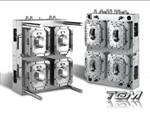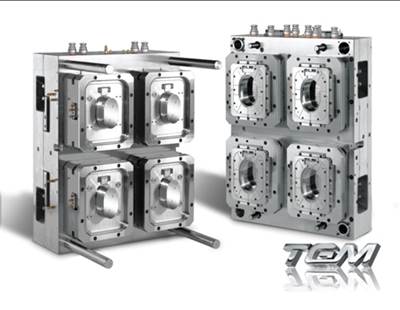The Business of Consumer Packaging Molding
A look at the tooling opportunities within the packaging/consumer products market.
During the past three years, we have seen many tool shops suffer from servicing just one industry. The danger of being so specialized is being buried with work when the market is good—forcing one to ignore opportunities from new customers in different business areas—or drying up entirely when sales are slow for an extended period of time. Much like your personal investment portfolio, diversification is the key to evening out the cycles all businesses go through.
One industry that must always re-invent its products is packaging—specifically, molded plastic components that act as a carrier and dispenser. A significant portion of the packaging industry supports products that are relatively unaffected by a down economy: lotions, soaps, beverages, medicines, hair care products and cleaning agents, to name a few. Consumers have been trained by decades of advertising to associate value with changes—especially those that impact functionality and ease-of-use—in packaging design.
For this article, we’ll look only at the top of the packaging industry: the caps, closures and dispensers on the containers. Many industries feature product lines employing containers needing highly engineered (tight tolerance / functional / air and water tight) closure devices: pharmaceuticals, cosmetics, personal care, horticultural, agricultural, medical, food/beverage, household, paint/paint sundries, chemical and electrical.
Opportunities in Caps, Closures and Dispensers
The caps market has an extraordinary number of unique applications because of the variety of fill-products (liquids, gels and powders) that go into the container and the variety of ways they have to come out of the container (poured, squeezed, shaken, sprayed and pumped). Each dispensing method has its own unique challenges. There are enough applications that few, if any, tool shops could claim to be master of them all (e.g., child resistant closures (push down/turn and squeeze/turn), disc caps, aerosol caps, dispensing caps, lotion pumps, liquid pumps, shaker/sifter caps, spigot caps, push pull closures, pop top closures, vented caps, flip tops, snap-on and snap-on/peel-off, sprayers, tethered closures and tamper-evident closures (threaded and snap-on/peel-off).
In the case of high-volume/high-cavitation production molds, the tool shop targeting the packaging industry must ultimately target the molders who service the OEMs. Custom molders of mass-market closures are among the most demanding in the plastics industry. The only way they can be successful is to run their molds like they entered a NASCAR race. Their customers require efficient production capacities in the millions and sometimes billions. High-volume, multiple tool set programs come with a sizable monetary value to the tool shops that service them. The cost of entry into this end of the packaging industry is demonstrable success within these applications.
It would be difficult, if not impossible, for a tool shop who has limited or no experience building high-cavitation/tight-tolerance/low-cycle time molds to break into the business. Guarantees of delivery and cycle time are the norm. Knocking on the door of the world’s leading cap molders and asking to become part of their RFQ list is not likely to be effective. Trying to buy your way in through significant price reductions is too risky—for you and them. Finding a niche in a lower-volume specialty application is more likely to yield results.
One strategy is to identify a specialty closure molder within your regularly serviced sales territory. For example, a small-to-medium sized company producing products to cap off and contain specialty cleaning solvents. If you are new to the packaging industry it is probable that you are not currently selling molds to this custom molder and this will be a cold call. It is unethical and unwise to present yourself as an experienced builder of living hinge closures, for example. Your lack of samples and unfamiliarity with performance objectives will quickly eliminate you from consideration.
Instead, have your sales person position your company as one who is committed to growing into their market. First, learn about the products they are manufacturing and for whom they work. Demonstrate your tool building prowess with any and all part samples of relative size and geometry. Gather your homework on several past projects to demonstrate your understanding and mastery of development and present your shop as a partner.
Ask for a chance with a project that is not overly time sensitive—one with a prototype phase is ideal. Communicate that you plan on finding the right opportunity to “invest in,” meaning you are willing to contribute additional (unbilled) hours in development, sampling and steel adjustments during the completion of the prototype mold. You have to give them a reason for giving you a chance. Let your customer know upfront that you appreciate the opportunity to learn, but that you are paying for your own education—not them. Dedicate your very best engineer, designer, toolmaker and project manager to this customer. Make certain your sales person maintains communication between your team and theirs.
If the prototype phase is a success, you should get consideration to build the production
mold and now you have a real example to help you land the next one.
If the project is cancelled—for any reason outside your area of influence—you still gained experience, exposure and insight into a new market, making you that much better prepared for the next opportunity.
Related Content
From Injection Mold Venting to Runnerless Micro Molds: MMT's Top-Viewed June Content
The MoldMaking Technology team has compiled a list of the top-viewed June content based on analytics. This month, we covered an array of topics including injection mold venting, business strategies and runnerless micro molds. Take a look at what you might have missed!
Read MoreMold Design Review: The Complete Checklist
Gerardo (Jerry) Miranda III, former global tooling manager for Oakley sunglasses, reshares his complete mold design checklist, an essential part of the product time and cost-to-market process.
Read MoreMold Builder Uses Counter-Intuitive Approach for Mold Challenges
Matrix Tool Inc. answers customers’ hard questions with creative solutions for cavity spacing, tool sizing, runner layout and melt delivery that reveal the benefits of running in a smaller press size at lower cavitation but higher yield.
Read MoreEditorial Guidelines: Editorial Advisory Board
The Editorial Advisory Board of MoldMaking Technology is made up of authorities with expertise within their respective business, industry, technology and profession. Their role is to advise on timely issues, trends, advances in the field, offer editorial thought and direction, review and comment on specific articles and generally act as a sounding board and a conscience for the publication.
Read MoreRead Next
Capitalizing on a Packaging Niche
Top Grade Molds Ltd. (TGM; Mississauga, ON) has always been known for its thin-wall, open top molds for the industrial packaging market.
Read MoreHow to Use Continuing Education to Remain Competitive in Moldmaking
Continued training helps moldmakers make tooling decisions and properly use the latest cutting tool to efficiently machine high-quality molds.
Read MoreHow to Use Strategic Planning Tools, Data to Manage the Human Side of Business
Q&A with Marion Wells, MMT EAB member and founder of Human Asset Management.
Read More








.jpg;maxWidth=300;quality=90)



_300x250 1.png;maxWidth=300;quality=90)









_970x250 3.png;maxWidth=970;quality=90)